Back in 2022, I wrote a piece looking at prior attainment in English and maths GCSE by Key Stage 5 subject choice. And some readers asked whether this varies by gender.
This seemed like a very good question, and I’m going to try and answer it here. I’ll be using data from the KS4 and KS5 pupil and exam tables from the National Pupil Database, focusing on pupils who completed KS4 in a state-funded school in England in 2019.
Some background
First, a note on how I’m defining ‘gender’. I’ll be referring to gender (as opposed to sex) throughout this post and will be using two categories: male and female. This is based on what the DfE records as part of the termly school census. Whether this is a good way of defining gender is open to question. But it’s what’s available to us in the data.
Now let’s look at how KS4 attainment breaks down by gender.
In 2019, female pupils’ attainment at GCSE was, on average, higher than that of male pupils. Their average Attainment 8 score was 50.4, compared to 45.5 for male pupils. This means that, on average, female pupils achieved the equivalent of a grade 5.0 in each of the qualifications that makes up their Attainment 8 score, while male pupils achieved the equivalent of half a grade lower.
The chart below shows the distribution of GCSE maths and English grades for male and female pupils.
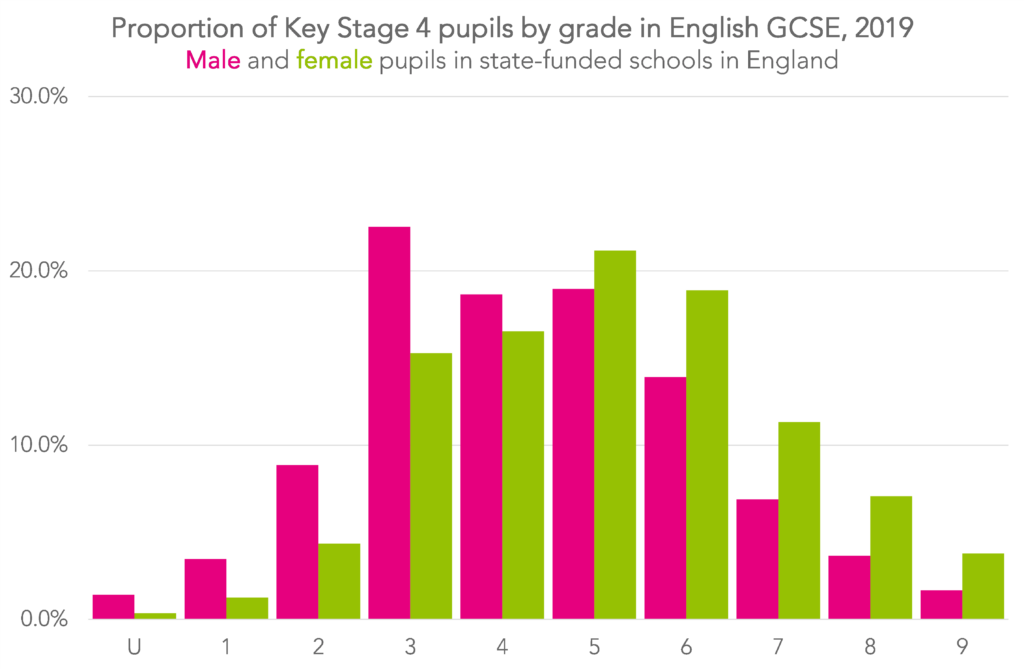
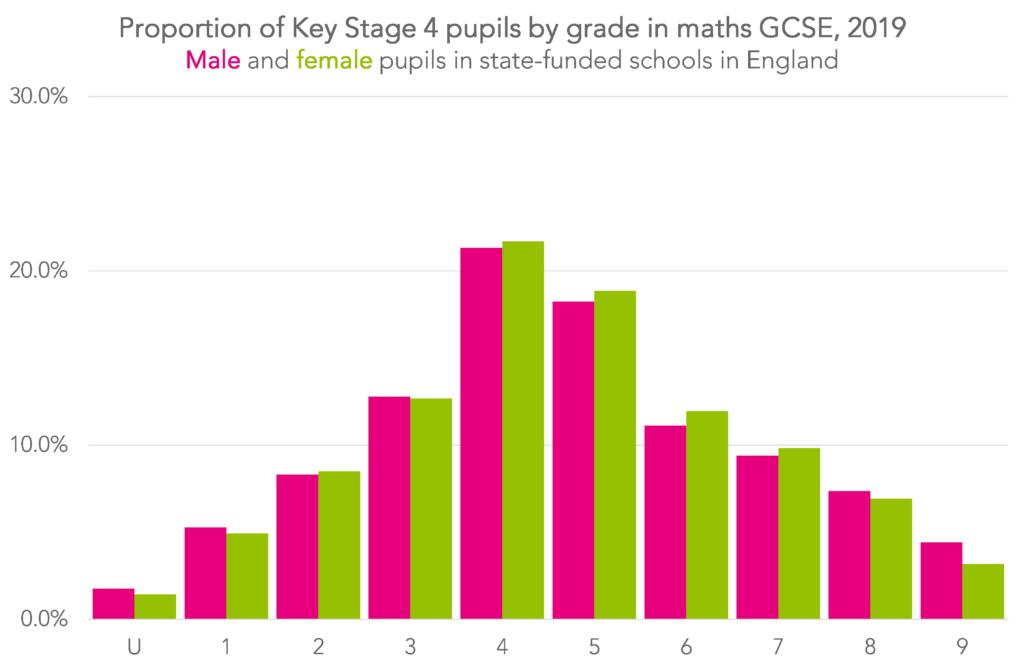
In English, male pupils’ grades are skewed towards the lower end, and female pupils’ towards the higher end; female pupils tended to get higher grades than male pupils. 22% of female pupils achieved a grade 7 or above in English, compared to 12% of male pupils.
But in maths, the distributions are very similar. Male pupils tended to achieve slightly higher grades but the difference was much smaller than in English: 20% of female pupils achieved a grade 7 or above in maths compared to 21% of male pupils.
The pattern looks a little different when we look at pupils who went on to enter a Level 3 qualification. Female pupils were more likely to do so than male pupils: 60% of those who completed KS4 in 2019 went on to enter a Level 3 qualification at the end of KS5 in 2021, compared to 47% of male pupils.
The chart below shows the grade distributions for those pupils who went on to enter a Level 3 qualification in 2021.
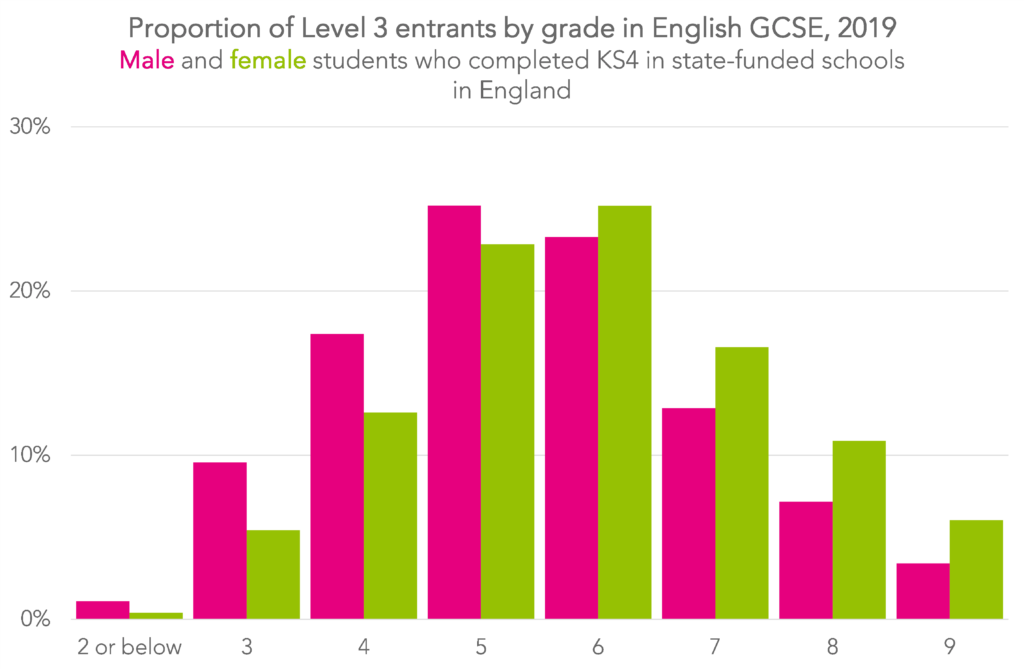

These pupils tended to achieve higher grades in both subjects than all KS4 pupils. And in English, female pupils’ grades tended to be higher than male pupils’, as we saw with all KS4 pupils: 33% of female pupils in this group achieved a grade 7 or above, compared to 23% of male pupils.
But – unlike for all KS4 pupils – there were quite large differences between male and female pupils in terms of maths GCSE grades. 31% of female pupils in this group achieved a grade 7 or above in maths, compared to 41% of male pupils.
Let’s see how this breaks down by subject.
Subject differences
We’ll include all KS5 subjects that had more than 5,000 entries in 2021 from students who completed KS4 in state-funded schools.
In all of these subjects, female students had achieved higher Attainment 8 scores, on average, than male students. But the difference was larger among students taking some KS5 subjects than others.
The chart below shows the difference in the average Attainment 8 score for female and male students by KS5 subject.[1]

The differences are highest in physics and computer science. In physics, the difference is close to five points – which is the equivalent of male students achieving half a grade less than female students in each of the subjects that make up the Attainment 8 score.
At the other end of the scale, religious studies and English language & literature have the smallest differences.
Now let’s look at GCSE grades in English and maths.
The chart below shows the difference in the average GCSE English grade for female students and male students by KS5 subject.
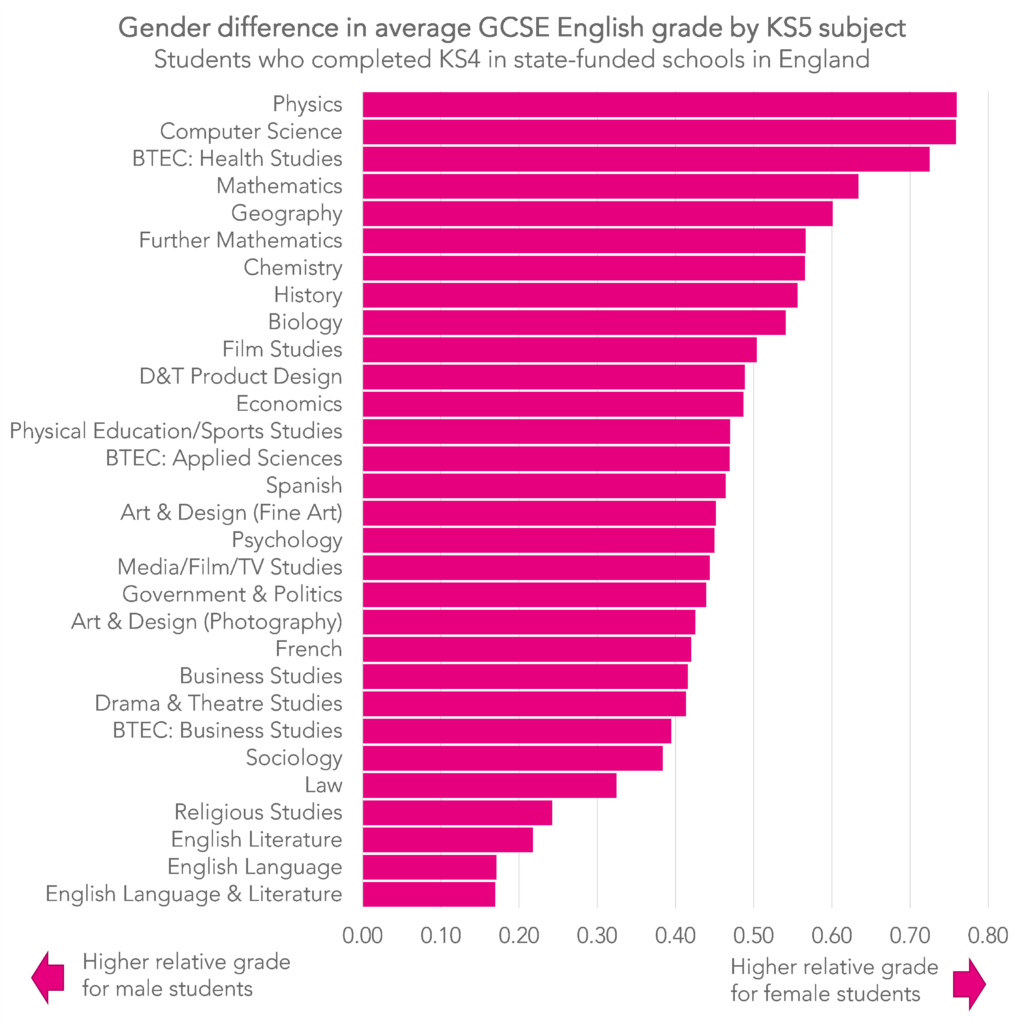
In all of the KS5 subjects included, the average grade for female students was higher than the average grade for male students. But – as with Attainment 8 scores – the difference was particularly high among students of physics and computer science.
The average GCSE English grade for female physics students was 6.9, compared to 6.1 for male physics students. For computer science, the figures were 6.6 for female students and 5.8 for male students.
There was also a large gender difference among BTEC Health Studies students; female students achieved an average GCSE English grade of 4.9, compared to 4.1 for male students.
The differences were smallest among students who took A-Level English.
Now for the difference in average GCSE maths grade.
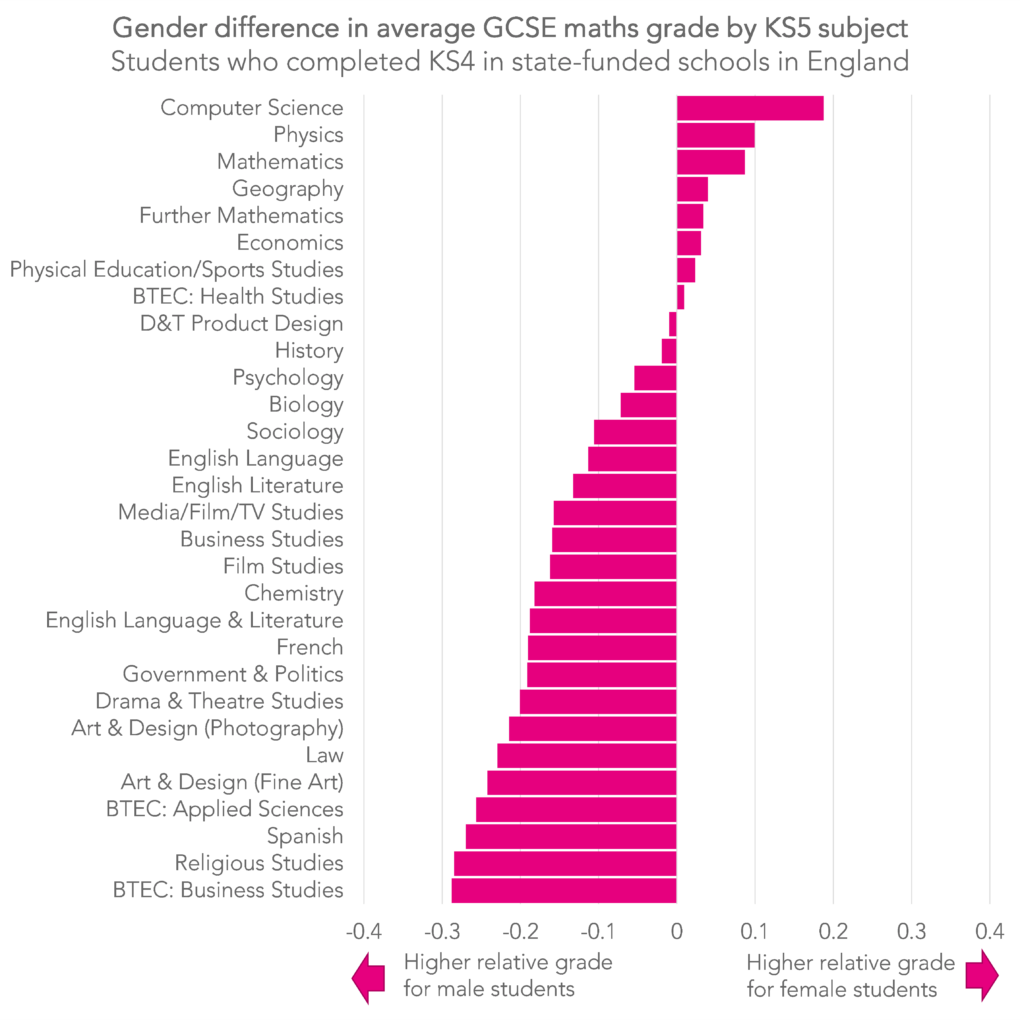
This looks rather different; in most KS5 subjects, male students’ average GCSE maths grade was higher than female students’, although the differences were smaller than for English grades. The subject with the largest difference was BTEC Business Studies, in which the average GCSE maths grade for male students was 4.7 compared to 4.5 for female students.
But there are some subjects that buck the trend. This includes physics and computer science, the subjects in which the differences between male and female students in terms of English grade was particularly high.
In both subjects, female students achieved slightly higher GCSE maths grades, on average, than male students. The average GCSE maths grades for female computer science students was 7.4, compared to 7.2 for male students. For physics students, the figures were 7.8 for female students and 7.7 for male students.
Gender balance and prior attainment
Some readers may have noticed that the two subjects in which female students’ average grades were highest relative to male students’ – physics and computer science – are also subjects with relatively few female students.
So could there be a link here? Perhaps particularly high attaining female students feel more confident about entering a subject in which they’re likely to be in a minority? And could the same be true of male students in subjects that are more popular with girls, like English and art?
Let’s take a look at how the difference in average female and male GCSE grades relates to the proportion of female students studying a KS5 subject.

There does indeed appear to be an association between relatively high English GCSE grades for female students and relatively low proportions of female students. Similarly, in subjects with a relatively low proportion of male students, the gender gap in attainment at GCSE English tends to be smaller.
There is a notable outlier on the top right of the chart – BTEC Health Studies. Over 90% of the students who entered this qualification were female, but it still had one of the highest gender differences in GCSE English grade.
Turning to maths grades, we see a slightly different pattern.
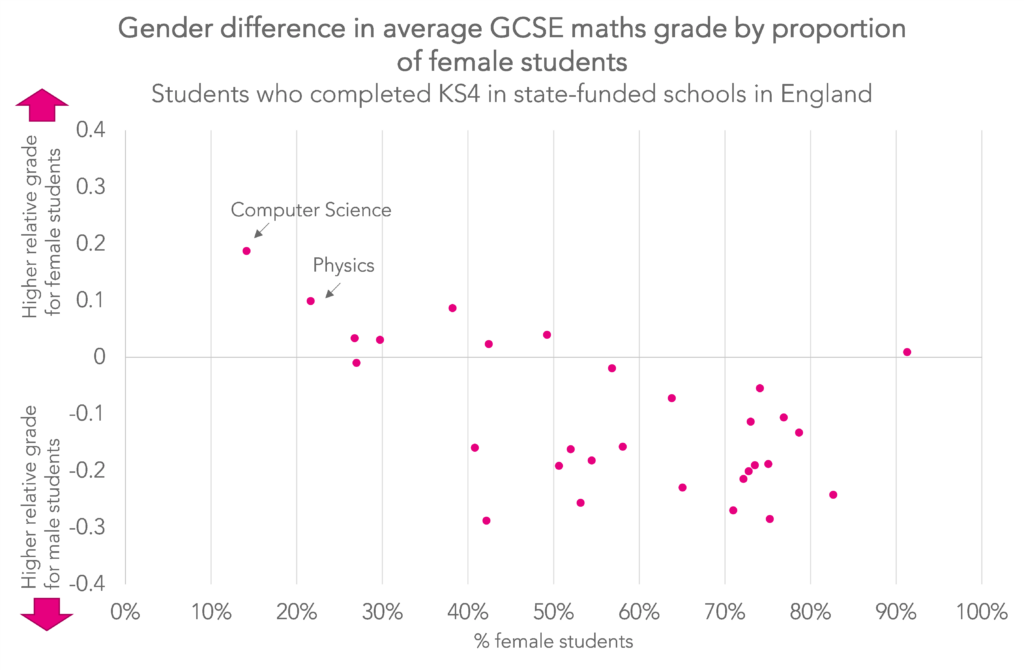
For subjects with a low proportion of female students, there does appear to be an association between the proportion of female students and the gender difference in GCSE maths grade.
But there isn’t such clear association when we look at subjects with more than around 40% female students.
The full grade distribution
For the sake of making some comparisons between subjects, we’ve been focusing on average grades. But readers with an interest in a particular subject may be keen to see more.
So the charts below show the full monty – you can select your subject of interest and see the grade distribution in both English and maths GCSE for male and female students.[2]
Summing up
The familiar differences in male and female attainment in GCSE English and maths do vary considerably when broken down by Key Stage 5 subject.
And there are some intriguing links between relative prior attainment and the proportion of female students studying a subject.
[1]: Subjects shown here are A-Level subjects, except where it’s specified that they are BTECs.
[2]: Data suppression rules do not allow us to publish any data based on fewer than 10 students. To avoid this, we have grouped some grades together. For every subject, we show the proportions achieving a grade of 2 or below rather than those achieving a U, 1 or 2 separately. For some subjects, we have also grouped other grades together where numbers were low.

Want to stay up-to-date with the latest research from FFT Education Datalab? Sign up to Datalab’s mailing list to get notifications about new blogposts, or to receive the team’s half-termly newsletter.



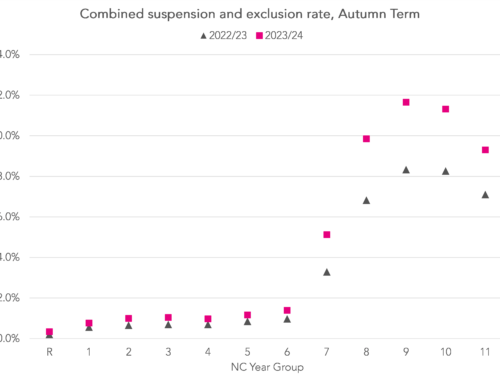

Leave A Comment